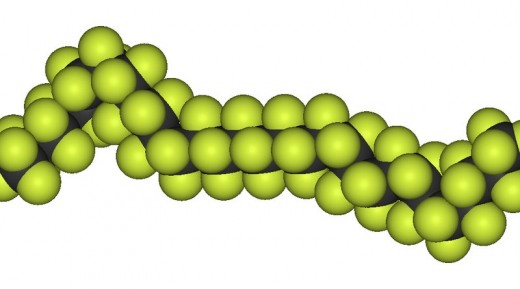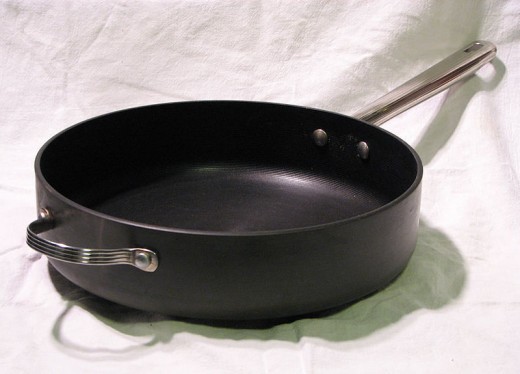Taking Care of Your Teflon Pots and Pans
What is Teflon
Teflontm is a registered trademark of Dupont Corporation. However, the word itself has come to mean almost any non-stick surface as applied to kitchen cookware, irons, fabric, bullets, pipe-tape, and a wide variety of other uses.
For the purpose of this article Teflon will be used in its more generic sense.
Polytetrafluoroethylene
Polytetrafluoroethylene (PTFE) is the actual name of this substance. It is a thermo-plastic which has a high melting point (327°C) for a polymer.
It is typically white in color in its unaltered state. It is the third most slippery substance known behind Aluminium magnesium boride (BAM) and diamond-like carbon. As an example a gecko lizard is not able to adhere to a surface coated with Teflon.
PTFE is also very non-reactive. This means as a coating to cookware it does not pick up or hold flavors nor does it react to acids such as those found in citrus or tomato.
Despite the high melting point PTFE will begin to degrade at 260° C or 500° F. This is an important consideration in cookware. Most ovens and range tops can easily reach or exceed this temperature.

Washing Teflon Cookware
You should never put your teflon cookware in a dishwasher for a full cycle. The reason is that most automatic dishwashers have a heat sterilzation cycle which will exceed the 500°F degradation temperature. Also, the detergents designed for automatic dishwashers is considerably stronger than detergents made for hand washing. Automatic dishwasher soap will also degrade, though more slowly, the PTFE coating on your cookware.
If you must wash your PTFE cookware this way be certain to stop the washer before it reaches the sterilization stage.
Hand Washing is Better
Hand washing is the preferred method of washing any PTFE coated cookware. This way you will avoid overheating it. Use your typical dish-washing liquid or powder, rinse thoroughly and hand-dry with a towel then season (see below) before cooking.

Pre-Season Your PTFE Cookware
If the pan or pot is brand new rinse it completely, hand dry it, and then season it, cold, with a little oil on a paper towel. This is before you even use it the first time.
Before cooking you should also pre-season your pots and pans with a teaspoon of oil or butter, on a paper or cloth towel, before submitting the cookware to heat. This because, despite the reputation of slipperiness, PTFE should still have a bit of lubrication before cooking.
Do not add the oil or butter to the pan while hot. This will ensure that it does not stick to the pan, but does stick to whatever you are cooking in the pan.
Using a Non Stick Spray
This should be fine as long as the spray you use is not made with soy-lecithin. In other words products with this minor ingredient can cause a baked/fried on sticky film that's impossible to remove. Even then you should apply the spray to the cool pan and then heat it to cooking temperature.
High Heat is "No No"
Temperatures above 500° F are guaranteed to ruin your cookware in no time at all. For that reason it's always best to start any item you are cooking in a non-stick pan at no more than medium heat.
PFOA
Perfluorooctanoic acid, also called PFOA or C8, is a by-product of non-stick cookware manufacturing. It is typically driven off under high heat during the process of adding PTFE to the pots and pans. PFOA is a known toxin and has been found to cause cancers in laboratory animals.
Though the industry claims that all PFOA should be completely driven off before the product is boxed and shipped, high heat cooking will certainly release this chemcial from the cookware if there is any left from the manufacturing process.
In short too much heat for any amount of time will destroy the non-stick properties of PTFE rendering your cookware completely non-stick in no time.
Storing PTFE Pots and Pans
Never nest your pans one inside the other. This is guaranteed to cause scratches and dings in the PTFE surface. Nor should you set any other type of kitchen cookware on the PTFE surface during storage.
If you must nest consider using a paper towel or napkin between each pot.
Cooking with PTFE Pots and Pans
You should never use metal utensils in your PTFE pots and pans. Teflon is applied in very thin coats from bare metal to the final finish. The actual non-stick part of that surface is very thin and any sharp metal object is certain to take a small chip of the top layer off.
Use wood, plastic, or bamboo utensils instead. Bamboo in particular is harder than most woods, will hold up better than plastic, and will not pick up and transmit odors and flavors. They are also easy to clean and dry quite quickly. Bamboo is also a recyclable/renewable wood.
Throw Away or Recycle
Once the PTFE starts coming off of the pan you do not want to cook on it any more. There are a number of reasons. First, once the non-stick is gone or on its way to no longer being effective you'll find that everything will stick to it no matter what you do. You also don't want to end up eating whatever PTFE remains on the pan, but flakes off onto your food.
You also do not want to reuse the pan as a pet dish. The same flakes that could harm you will certainly harm your pets.
Reuse the Pan
If they are really excellent pans and you can't bare to lose them consider taking them to an auto refinishing company and have the company use crushed walnut shell to completely remove all the remaining PTFE. If the pan is steel or stainless steel this might be a good option. Crushed walnut shell, as a blasting agent, does not cut as deeply into the underlying metal and is environmentally sound as it is recyclable.
This can be an expensive option though costing up to $100.00 for four or five pans. Still, if they are really good pans this might be an option to consider.
Recycle the Pan
In this instance recycle means re-coating the pan with PTFE. Contact the maker of your cookware set and see if they'll resurface your pans. Be aware however, that this could be an expensive proposition.
Calphalon has a recycling program Calphalon Renew, but it requires you to buy a new set of pots and pan (made by Calphalon naturally) to implement the recycling.
Curbside Recycling
Finally, contact your waste disposal company regarding recycling PTFE coated cookware.
Coda
In the creation of this article I've found a number of sources that insist or imply that PTFE cookware causes reproductive problems in women, kills pets, especially birds, and is just absolutely a "no no" in cookware.
I don't know how much (if any) of this is true, but I typically err on the side of caution.
Not in this case though. I have had my very thick (beautiful heat distribution) PTFE cookware for over eight years now and despite the fry pan looking a bit worse for wear (thanks to a heavy handed metal utensil wielding guest) the stuff is still non-stick, looks almost new and cooks like a dream.
I always hand-wash them, never use anything more than a sponge (never the scrubbing side), never use anything but wood or bamboo tools, and never over-heat them. That's a lot of "nevers," but my pans still look and cook pretty good if not great.
Still, if you are concerned about potential risks avoid PTFE cookware entirely.
Disclaimer
The author was not compensated in any way, either monetarily, with discounts, or freebies by any of the companies mentioned.
Though the author does make a small profit for the word count of this article none of that comes directly from the manufacturers mentioned. The author also stands to make a small profit from advertising attached to this article.
The author has no control over either the advertising or the contents of those ads.





